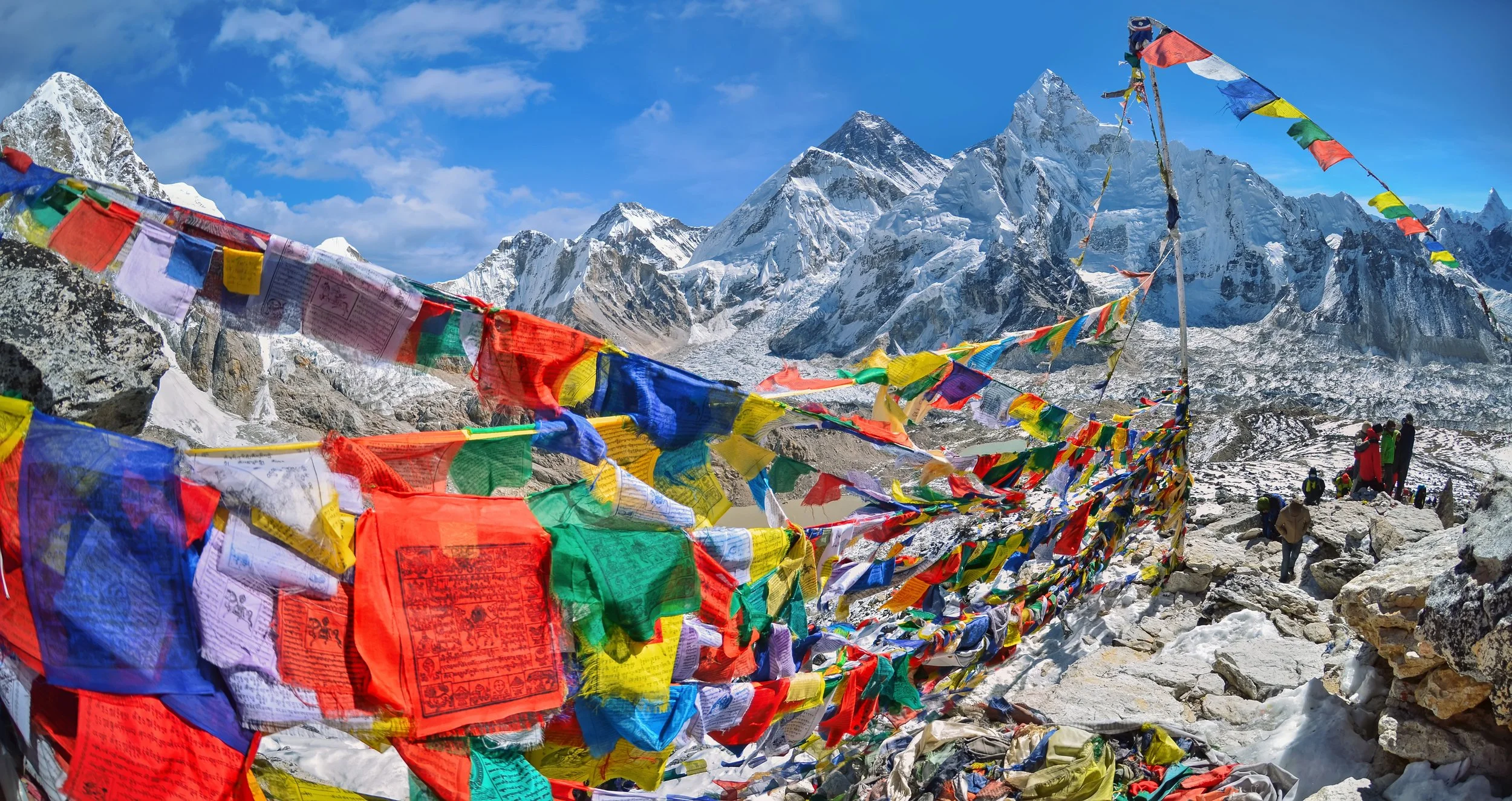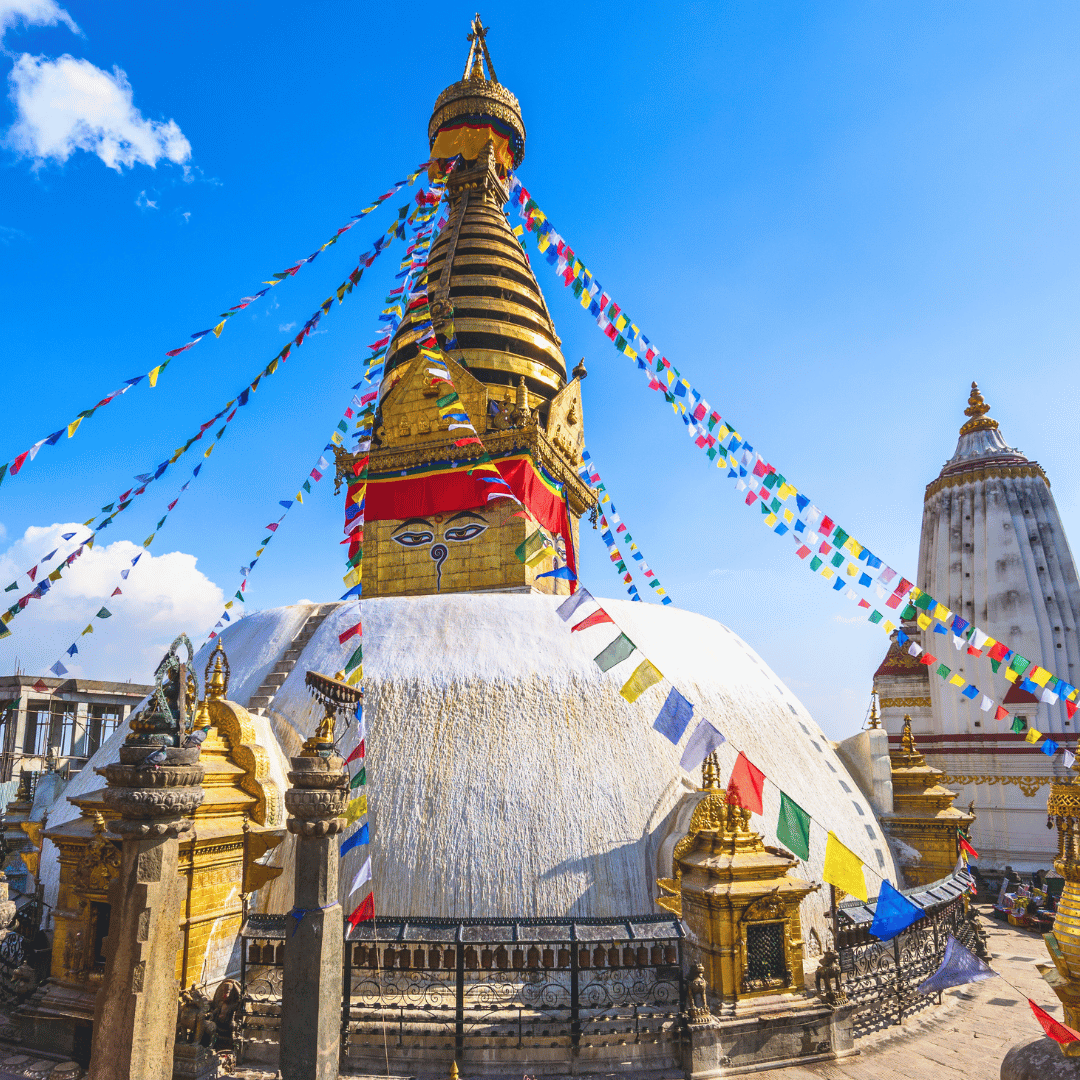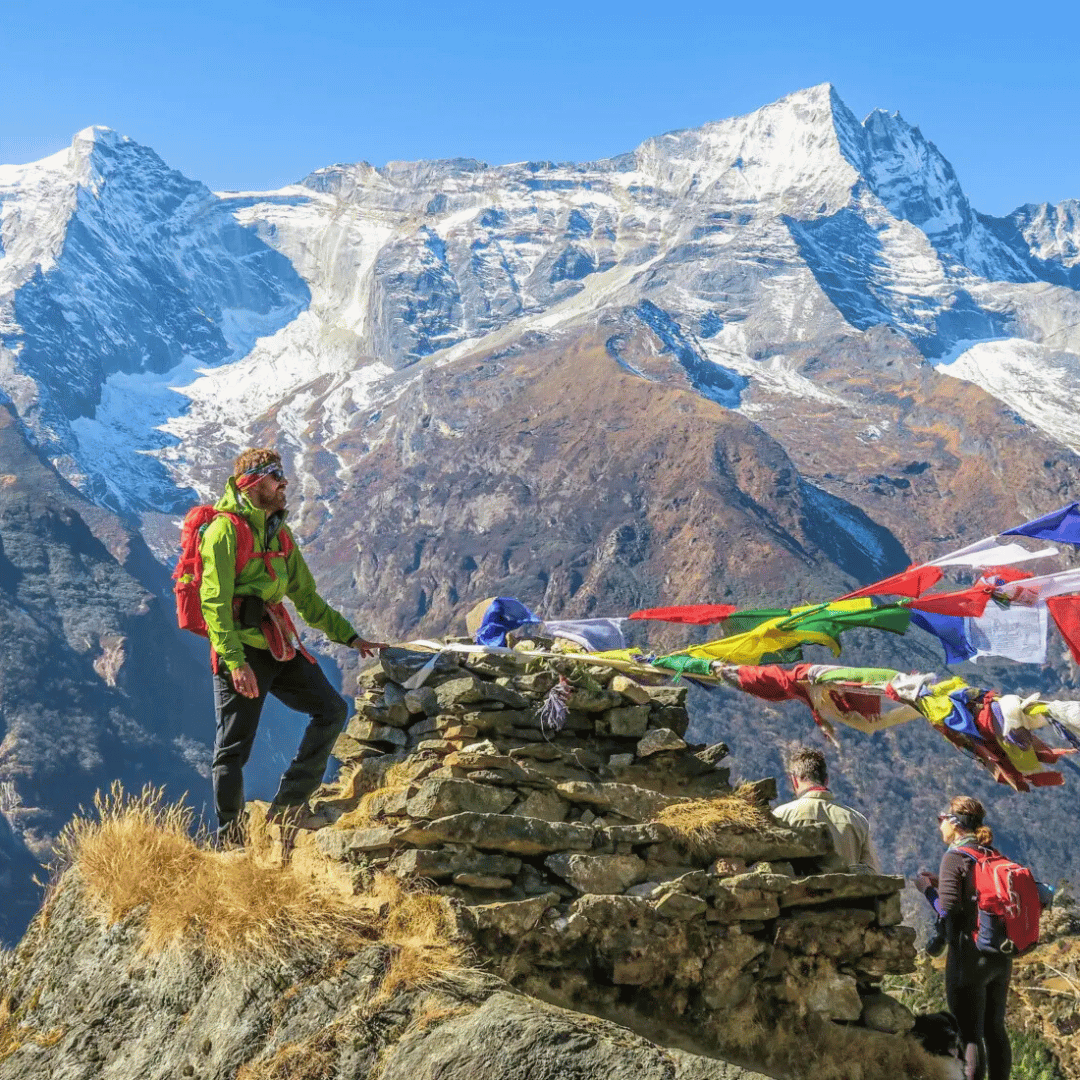
Nepal Private Tour Packages
Bespoke Itineraries Designed For Australian Travellers
Nepal is a land of soaring peaks, ancient cities and timeless traditions, where Himalayan landscapes meet centuries of cultural heritage. From Kathmandu’s temple squares to Bhaktapur’s medieval alleys and Patan’s artisan workshops, history and spirituality are ever-present. In the Annapurna foothills, terraced villages and panoramic trails offer breathtaking mountain views, while Chitwan National Park reveals rhinos, elephants and rare birdlife on jungle safaris. Pokhara provides a peaceful lakeside setting with adventure options from paragliding to boating.
Private tours of Nepal can be shaped to your interests, balancing comfort with discovery, whether that means exploring UNESCO World Heritage sites, trekking between mountain lodges, or joining a local cooking class. Travellers may find themselves watching sunrise over the Himalayas, meeting monks in remote monasteries, or drifting along a jungle river by canoe. Whether your focus is culture, adventure or wildlife, Nepal private tour packages provide a rewarding and immersive way to experience this remarkable country. At Asia Unbound, we design private journeys across Asia for Australian travellers seeking flexible, well planned experiences and genuine cultural connection.
Our Best Nepal Tour Itineraries
Nepal Travel Advice For First Time Visitors
-
Nepal is a country that captivates travellers with its mix of Himalayan landscapes, ancient traditions, and living spirituality. The culture is shaped by both Hinduism and Buddhism, and visitors will encounter sacred temples, monasteries, and stupas that remain central to daily life. Festivals, processions, and religious rituals are frequent and provide meaningful insight into Nepalese society.
Entry requirements are straightforward. Most travellers, including Australians, need a visa, which can be arranged online before travel or upon arrival at Kathmandu’s Tribhuvan International Airport. Passports must be valid for at least six months beyond your intended stay. An online arrival form is also required, which should be completed in advance to speed up immigration.
Connectivity is generally good in cities and main towns. Wi-Fi is widely available in hotels, cafés, and airports. Affordable local SIM cards and eSIMs make it easy to stay connected, though coverage may be inconsistent in rural areas and mountain regions. Despite this, basic mobile access is available in many trekking areas, which allows for contact even in remote parts of the country.
Medical care in Nepal is best accessed in Kathmandu and Pokhara, where private hospitals and clinics provide international-standard services and English-speaking staff. Outside of these hubs, healthcare facilities are limited, so comprehensive travel insurance is strongly recommended. Pharmacies are common in larger towns, but travellers should carry any regular prescriptions and essential medications with them.
Transport around Nepal can be part of the adventure. Domestic flights connect major cities and regions, although delays are possible due to the country’s geography. Road travel offers scenic journeys but can be slow and bumpy. For comfort and flexibility, private transfers with a driver-guide are the best option for exploring the cultural heartlands, hill towns, and national parks.
Safety-wise, Nepal is considered welcoming and generally safe for visitors. As in any country, it’s best to take normal travel precautions, such as keeping valuables secure and being mindful in crowded areas. The warmth and hospitality of the Nepalese people are often highlighted as one of the most memorable aspects of travelling here.
Overall, travelling to Nepal is as much about the experience as the destination itself. With preparation for entry, awareness of logistics, and openness to cultural traditions, a journey here becomes an enriching blend of discovery, connection, and reflection.
-
Nepal does not have states in the same sense as Australia or the United States. Instead, the country is divided into 7 provinces, created under the 2015 constitution, which are then subdivided into districts. Each province has its own unique geography, culture, and travel highlights.
Province No. 1 lies in the east and is home to some of Nepal’s highest mountains, including Everest, Kanchenjunga, and Makalu. Treks through the Everest region and tea-growing hills of Ilam are major draws here.
Madhesh Province stretches along the southern plains known as the Terai. It borders India and is known for fertile farmland, vibrant market towns, and strong cross-border cultural influences.
Bagmati Province is the country’s political and cultural centre. It contains the Kathmandu Valley, home to the capital city Kathmandu along with Patan and Bhaktapur, where UNESCO-listed temples, palaces, and stupas reveal Nepal’s layered history.
Gandaki Province is one of the most popular for travellers. Pokhara sits at its heart, offering lakeside scenery and access to the Annapurna region. The province also includes Mustang, with its dramatic arid landscapes and Tibetan-influenced culture.
Lumbini Province takes its name from Lumbini, the birthplace of the Buddha. Beyond this sacred site, the province includes historic hill towns such as Tansen and parts of the Terai that connect to Chitwan.
Karnali Province is remote and less developed, offering some of Nepal’s most unspoiled trekking regions. Highlights include Rara Lake and Shey Phoksundo National Park, both known for their natural beauty and sense of isolation.
Sudurpashchim Province lies in the far west. It combines Himalayan terrain, lowland Terai, and a rich cultural mix. Fewer tourists venture here, making it a destination for travellers seeking authentic, off-the-beaten-path experiences.
Together, Nepal’s seven provinces illustrate the country’s incredible diversity - from the world’s highest peaks and Buddhist landmarks to wildlife-rich plains and remote mountain valleys. Each province contributes to the cultural and natural richness that makes Nepal so rewarding to explore.
-
The official language of Nepal is Nepali, an Indo-Aryan language written in the Devanagari script. It is spoken across the country and used in government, education, and media, serving as a unifying language among Nepal’s many ethnic groups.
Nepal is highly multilingual, and more than 120 languages are spoken by different communities. In the Kathmandu Valley, Newari (Nepal Bhasa) has deep cultural roots, while in the Terai plains, many people speak Maithili, Bhojpuri, and Tharu. In the hills and mountains, languages such as Tamang, Gurung, Sherpa, Magar, and Rai remain strong in daily life and traditions.
English is also widely understood, particularly in cities, tourist centres, and among younger generations. It is commonly used in hotels, trekking lodges, and with guides, making travel relatively straightforward for visitors.
Nepal’s linguistic diversity reflects its cultural richness. It’s common to hear several languages spoken in one marketplace or village, often alongside Nepali as the shared national tongue.
-
Nepal is a country that can be visited year-round, but the best time to travel depends on what you want to see and do. Because it stretches from the lowland Terai plains to the world’s highest mountains, each season offers very different possibilities.
The most popular periods are Spring (March to May) and Autumn (September to November). These are considered the peak travel seasons for good reason. Spring brings warm days, blooming rhododendrons in the hills, and lively festivals such as Holi and the Nepali New Year. It is an excellent time for trekking in the Annapurna or Everest regions, exploring national parks, and sightseeing in the Kathmandu Valley. Autumn is equally rewarding, with clear skies that reveal sweeping Himalayan views. The major festivals of Dashain and Tihar fall during this period, adding rich cultural experiences to any journey.
Winter (December to February) is quieter but still a fine time for travel. Kathmandu, Pokhara, and the lowlands enjoy mild days, while the higher Himalayas are cold and snowy. This season is excellent for cultural exploration, birdwatching in the Terai, and safaris in Chitwan and Bardia National Parks, where wildlife viewing is at its best.
Summer and Monsoon (June to August) bring rain to much of the country, which deters many travellers. However, this season has its own rewards. The countryside is lush and green, waterfalls are at their most impressive, and villages host smaller local festivals. Importantly, regions like Mustang and Dolpo, which sit in the Himalayan rain shadow, remain accessible and provide some of Nepal’s most unique trekking and cultural experiences.
In short, Nepal offers something in every season. Spring and autumn are best for mountain views and cultural touring, winter is ideal for wildlife and a slower pace, while the monsoon opens up less-travelled regions for adventurous travellers. No matter when you go, the mix of landscapes, traditions, and hospitality makes Nepal a rewarding destination.
-
In Nepal, what you wear depends on where you are travelling and the type of experiences you plan to have. The country’s varied geography means you may find yourself in a bustling city one day, a Himalayan village the next, and a jungle environment soon after.
In cities such as Kathmandu and Pokhara, visitors will notice a mix of traditional and modern dress. Day-to-day, lightweight and breathable clothing is practical for sightseeing and moving between neighbourhoods. When visiting temples, monasteries, and religious sites, it is respectful to cover shoulders and knees. Shoes should be removed before entering places of worship.
For mountain areas like Dhampus, Sarangkot, or the Annapurna foothills, comfortable walking clothes are important. Even if you are not undertaking a long trek, sturdy footwear and a warm layer for cool mornings and evenings will make short hikes and village walks more enjoyable.
In jungle regions such as Chitwan or Bardia, neutral-coloured, lightweight clothing is best for safaris and canoe rides, as it helps you blend into the environment and stay comfortable. A hat and long sleeves can be useful for sun and insect protection.
Overall, dressing in Nepal is about combining practicality with respect for local customs. Modest, comfortable clothes will work in almost every setting, while a few well-chosen layers will prepare you for the country’s diversity of landscapes and activities.
-
Food in Nepal is as diverse as its people and landscapes, reflecting influences from South Asia, Tibet and the many ethnic groups that call the country home. Eating here is not just about sustenance, it is a window into daily life, hospitality and centuries of tradition.
The national staple is dal bhat, a combination of rice, lentil soup, vegetables, pickles and often meat or fish. It is eaten by almost everyone, usually twice a day, and families take pride in their unique variations. The phrase “dal bhat power, 24 hour” is a playful nod to how central it is to Nepali life.
Momo, steamed or fried dumplings, are perhaps the most beloved snack or light meal. Stuffed with chicken, buffalo or vegetables and served with tangy chutneys, they are found everywhere from roadside stalls to fine restaurants. For many visitors, trying momo becomes a daily ritual.
In the Kathmandu Valley, Newari cuisine offers an especially rich culinary heritage. Traditional feasts can feature dozens of small plates, including spicy grilled meats, lentil pancakes, fermented vegetables and sweet dumplings called yomari. These meals are often tied to festivals and family gatherings.
In the Himalayan regions, Tibetan influenced dishes like thukpa (a warming noodle soup), tsampa (roasted barley flour) and butter tea provide comfort and energy. These foods reflect the lifestyle of high altitude communities and the close cultural links with Tibet.
In the Terai plains, cuisine leans towards Indian traditions, with flatbreads, spiced vegetables and curries forming everyday meals. Here, influences from Bihar and Uttar Pradesh blend with local Tharu traditions, creating distinctive flavours.
Street food culture is lively across the country. In Kathmandu and Pokhara you will find stalls selling fried snacks, spicy chaats and sweets, while in smaller towns local markets are the best place to sample fresh produce and regional dishes.
Tea is ever present. Sweet milk tea is the standard offering in most homes and cafés, while in Himalayan villages visitors may be offered butter tea, made with yak butter and salt. It is a unique taste but deeply tied to the culture of the mountains.
Eating in Nepal is part of the travel experience. From hearty staples to festive feasts, from roadside snacks to family kitchens, every meal offers a chance to connect with the country’s warmth, hospitality and extraordinary diversity.
-
The ideal amount of time in Nepal depends on the kind of journey you are looking for. The country is compact but incredibly varied, offering everything from ancient temples and bustling bazaars to mountain panoramas and wildlife safaris. Because of this diversity, you can design a trip that is short and focused or one that is more extended and wide ranging.
For a short introduction of 5 to 7 days, travellers usually base themselves in Kathmandu and Pokhara. In Kathmandu you can explore UNESCO World Heritage sites such as Durbar Square, Swayambhunath and Pashupatinath, and enjoy the vibrant atmosphere of the old bazaars. A scenic drive or short flight takes you to Pokhara, where you can relax by Phewa Lake, visit caves and waterfalls, and take a sunrise excursion to Sarangkot for views of the Annapurna range. This length of stay is enough for a first taste of Nepal’s culture and scenery without being rushed.
A well balanced journey of 10 to 14 days allows you to combine the cities with light adventure and nature. You might begin in Kathmandu Valley, then travel to Bandipur for a glimpse of Newari village life before continuing to Pokhara. Short hikes to places such as Australian Camp or Dhampus give you a chance to enjoy Himalayan views without the demands of long treks. A few days in Chitwan National Park add another dimension, with jeep safaris, canoe rides and birdwatching. This length of trip provides cultural depth as well as varied landscapes and wildlife.
For a longer exploration of 2 to 3 weeks, you can connect the full breadth of Nepal’s highlights. In addition to Kathmandu, Pokhara and Chitwan, you might include Lumbini, the birthplace of Buddha, and historic hill towns like Tansen. More time allows for overnight hikes in the Annapurna foothills or even a dedicated trekking program in Mustang or Langtang. Extended journeys also provide the chance to slow down, stay in smaller lodges, and spend time in remote communities. With this timeframe, you gain a richer and more complete perspective on Nepal’s cultural traditions, sacred landscapes and natural diversity.
In summary, Nepal rewards even a brief visit, but the longer you stay, the more layers you uncover. A week offers a snapshot, two weeks balances culture, wildlife and light adventure, and three weeks or more opens up the full range of experiences that make Nepal such a captivating destination.
-
Yes, a private tour of Nepal can be combined very easily with neighbouring countries, and the most popular pairings are India and Bhutan. Together, these destinations offer an incredibly rich journey across the Himalayas and South Asia, blending diverse cultures, landscapes, and traditions.
Pairing Nepal with India opens the door to extraordinary contrasts. Many travellers begin with the temples, palaces, and bazaars of the Kathmandu Valley before flying to Delhi or Varanasi. This allows you to experience both Hindu and Buddhist heritage, from Pashupatinath in Nepal to the ghats of the Ganges. You could also connect Nepal’s wildlife parks, such as Chitwan, with India’s tiger reserves or combine mountain panoramas with the iconic Taj Mahal. Frequent direct flights link Kathmandu to Delhi, Varanasi, and other major Indian cities, making these two countries a natural match for a private itinerary.
Combining Nepal with Bhutan creates a different kind of journey, centred around the shared landscapes and spiritual traditions of the Himalayas. Many travellers choose to explore Kathmandu and Bhaktapur before flying to Paro, where Bhutan’s monasteries and fortress-like dzongs rise from dramatic valleys. Highlights include the cliffside Tiger’s Nest Monastery, Punakha Dzong, and scenic drives across high mountain passes. While both countries are rooted in Buddhist culture, Bhutan’s philosophy of Gross National Happiness and carefully preserved traditions make it a fascinating complement to Nepal’s more diverse and outward-facing character.
Coordinating such journeys across multiple borders, however, can be complicated. Visas, flight connections, local guides, and transfers all need careful planning to ensure the experience flows seamlessly. This is where travelling with a private operator like Asia Unbound makes a real difference. With expert local knowledge and international support, Asia Unbound ensures your itinerary is carefully tailored, all logistics are handled, and the balance between culture, nature, and relaxation is preserved. Rather than worrying about airport transfers, permits, or timings, you can focus entirely on the journey itself.
Popular Places To Visit In Nepal
Plan Your Nepal Itinerary With Asia Unbound
Established in 2007, Unbound Travel Group is a collection of tourism brands specialising in highly curated private touring and small group journeys throughout Asia. With more than two decades of experience, we create bespoke itineraries for discerning travellers looking for a real adventure. Based in Australia, our team uses our on-the-ground experience and first-hand knowledge to carefully curate experiences that are innovative and authentic.
When you start to research a trip to Asia, it’s easy to feel overwhelmed by the seemingly endless possibilities, especially if you don’t want to join a group tour. At Asia Unbound, we’ve made this process easy. We simply need you to tell us relevant information about yourself and the type of travel experience you are looking for - whether it’s a wish list of places you want to visit, a style of travel, a particular interest or theme that you want to explore, or all of these factors. Using this information, we curate a custom-made Asia private tour just for you. It’s that simple.
Nepal Hotel Recommendations



















